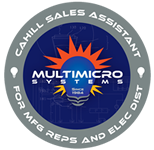Data is the cornerstone of success for high-achieving sales teams. In their customer relationship management (CRM), enterprise resource planning (ERP), and other systems, sales executives have an abundance of data at their disposal, which is good news for those seeking to beat the competition, build their sales staff, optimize profit, or improve sales. To meet or surpass sales targets, sales teams must recognize the most significant data points and key performance indicators (KPIs), analyze the results, and take appropriate action. Well-defined sales KPIs are a useful tool for achieving this.
Sales representatives usually concentrate on more tactical KPIs, but sales managers employ high-level, holistic sales KPIs that give visibility into the performance of the entire sales team. A sales representative might be more concerned with how many meetings or deals need to be closed in order to fulfill quota, whereas a sales manager might aim to shorten the sales cycle or increase pipeline value. The capacity of a team to convert sales KPIs into a workable plan can have a favorable effect on the bottom line regardless of position.
1. Sales Revenue
The ultimate measure of success for most sales teams. Track overall sales, individual rep performance, and compare to targets to gauge progress and identify areas for improvement.
Sales revenue, a vital metric for businesses, represents the total income generated from selling goods or services over a specific period. It serves as a cornerstone in assessing a company’s financial health and performance. By analyzing sales revenue, businesses gain insights into their market position, customer demand, and effectiveness of sales strategies. Increasing sales revenue is often a primary objective, achieved through various means such as expanding market reach, enhancing product offerings, optimizing pricing strategies, and improving sales processes. Moreover, tracking sales revenue enables businesses to identify trends, forecast future performance, and make informed decisions to drive growth. Ultimately, Robust Sales Revenue signifies a thriving business, indicating successful customer engagement, strong market presence, and sustainable profitability. As businesses navigate dynamic markets, prioritizing strategies to maximize sales revenue remains paramount for long-term success and competitiveness.
2. Sales Growth Rate
Monitor the percentage increase in sales over time to assess performance and identify growth trends.
Sales growth must be tracked over time by every sales manager. Sales leaders can identify and address issues more rapidly when there is a monthly increase in sales.
Offering substantial discounts, for instance, can draw in more interested customers if a vehicle dealership experiences a decline in monthly sales following the holidays.
Establishing monthly goals for sales growth provides members of the sales team something to strive for in four-week sprints, which in turn encourages them to perform effectively.
Method for figuring the monthly sales growth:
Monthly sales growth = ((Sales for the current month − sales for the previous month) ÷ sales for the prior month) × 100
3. Average Purchase Value
The average amount that consumers spend on your goods or services is known as the average purchase value. It’s a perfect metric for businesses looking to increase revenue from their present clientele. Determining the average consumer spending amount per purchase might shed light on the factors that led to larger transactions. You can also determine which consumers spend the most money if you break this down by client segment.
How to figure out the average buying price:
Average purchase value = Total sales ÷ number of customers or transactions
4. Average Deal Size: The Money Maker Metric
That’s Average Deal Size (ADS), measuring the typical value of your closed deals. It’s crucial because:
- Reflects efficiency:Higher ADS means each sale brings in more revenue, potentially indicating a smoother sales process or focusing on higher-value clients.
- Guides strategy:Analyze ADS by product, segment, or rep to identify high-performing areas and adjust strategies for improvement.
- Boosts growth:Increasing ADS can significantly impact overall revenue without needing more customers.
Think of it like this: You sell lemonade. Selling 100 cups at $1 each gets you $100. But selling 50 cups at $2 each brings in the same amount. ADS helps you optimize that “price per cup” for maximum impact.
Remember, it’s a starting point:
- Track trends over time to see if ADS is increasing or decreasing.
- Compare your ADS to industry benchmarks to see where you stand.
- Consider offering incentives or value-added services to increase ADS.
By monitoring and leveraging your Average Deal Size, you can turn up the heat on your sales success!
5. Customer Acquisition Cost (CAC)
Customer Acquisition Cost (CAC) is the total expense your business incurs to acquire a single new customer. Think of it like an investment in each customer relationship. By understanding CAC, you can see how efficiently your marketing and sales efforts are converting leads into paying customers.
Here’s how it works:
Calculate: Add up all your sales and marketing expenses (ads, salaries, events, etc.) over a specific period. Then, divide that number by the number of new customers acquired during that same period.
Benefits: Knowing your CAC helps you:
- Optimize spending:Identify areas where you can acquire customers more cheaply.
- Set realistic goals:Understand how much you can afford to spend to reach your growth targets.
- Make better decisions:Compare CAC to Customer Lifetime Value (CLTV) to see if your customers are generating enough revenue to justify the acquisition cost.
So, CAC is crucial for businesses to understand the true cost of their customer base and make informed decisions about growth strategies. Aim for a healthy CAC that’s lower than your CLTV for sustainable success!
CAC = Total sales and marketing costs ÷ net new customers
6. Lead Conversion Rate
The percentage of leads that become sales is known as the lead conversion rate, also known as the lead-to-sale conversion rate.
Your sales team’s win rate can be ascertained by concentrating on sales-qualified leads. To gauge sales success and make sure marketing teams collaborate to convert leads, you can also compute it in a broad sense.
How to figure out the conversion rate of leads:
Lead conversion rate = (Total number of sales ÷ total number of leads) × 100
“Measure the percentage of leads that convert into paying customers to identify weaknesses in the sales funnel and improve lead nurturing.”
7. Average Sales Cycle Length
“Track the average time it takes to close deals to identify bottlenecks and optimize the sales process for faster conversions.”
The average sales cycle length is the typical time it takes to convert a lead into a paying customer. Think of it as the journey from initial contact to final purchase. It’s crucial for businesses as it impacts revenue, efficiency, and resource allocation.
Why it matters:
Identifies Bottlenecks: A long cycle highlights inefficiencies in your Sales Process, allowing you to streamline and speed things up.
Improves Forecasting: Knowing the average time for deals helps predict future revenue and resource needs.
Benchmarks Performance: Compare your cycle length to industry standards to see where you stand and identify areas for improvement.
Key Factors Influencing IT:
Product Complexity: Complex products usually require longer decision-making periods.
Buyer Type: Businesses often have longer cycles compared to individual consumers.
Sales Process: Well-defined and efficient processes contribute to shorter cycles.
Remember: This is just an average, individual deals can vary significantly. By tracking and analyzing your sales cycle length, you can gain valuable insights to optimize your sales process and drive growth.
Quota Attainment: Monitor individual and team progress towards sales targets to hold reps accountable and motivate performance.
Win Rate: Measure the percentage of proposals or quotes that convert into closed deals to assess sales effectiveness and identify areas for improvement in the pitching process.
8. Sales Target Attainment
Sales target attainment, also known as quota attainment, measures how well a salesperson or team achieves their predetermined sales goals. It’s a crucial metric for businesses as it directly impacts revenue, profitability, and growth.
Think of it as a finish line for sales reps. It motivates them to push for specific revenue or unit sales numbers within a set timeframe. By tracking this metric, businesses can:
- Assess individual and team performance: Identify top performers, areas for improvement, and potential coaching needs.
- Identify trends and adjust strategies: Adapt to market changes, resource allocation, and product mix based on attainment data.
- Motivate and reward: Set achievable targets to drive healthy competition and incentivize performance.
- Measure overall sales effectiveness: See if sales efforts are translating into desired outcomes.
Sales target attainment goes beyond just hitting numbers. It’s about setting realistic goals, tracking progress, and making data-driven decisions to continuously improve sales performance and ultimately, fuel business success.
Sales target attainment = (Sales for the current period ÷ sales target) × 100
9. Sales Opportunities
Based on the likelihood of closing the deal, sales opportunities calculate a lead’s worth. Sort prospects into groups or phases (such as proposal, qualification, or negotiation), and then assign varying weights to each group according to how the opportunity develops.
Sales opportunity = Value of sale × opportunity status
10. Customer Satisfaction Score
Measure customer satisfaction through surveys or feedback tools to identify areas for improvement and ensure a positive customer experience.
The Customer Satisfaction Score (CSAT) is a key metric that measures how happy your customers are with a specific interaction, product, or service. It’s like a temperature check, letting you know if your customers are feeling warm and fuzzy (satisfied) or cold and distant (unsatisfied).
Typically measured through surveys with a simple scale (e.g., 1-5 stars), it provides a quick snapshot of customer sentiment. High CSAT scores indicate satisfied customers, leading to loyalty, positive word-of-mouth, and repeat business. Conversely, low scores signal areas for improvement, allowing you to address issues and prevent churn. CSAT is valuable because it’s actionable and industry-agnostic. It goes beyond sales numbers, revealing the true feelings of your customers, which are crucial for long-term success. So, listen to your CSAT score, understand what it tells you, and take action to keep those customers happy!



